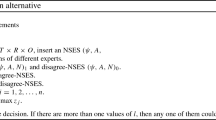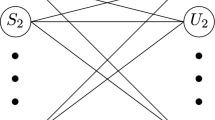Abstract
Requirements of the electromagnetic intensities of radio waves in a wireless communication basic-station (WCBS) system could be reduced into a system of fuzzy relation inequalities with max-product composition. In order to check the consistency of a WCBS system with some non-working basic stations, we first introduce the consistency checking method for a WCBS system without any non-working basic station. An index set approach is designed for the consistency checking, with some numerical examples illustrating the effectiveness of our proposed approach. Moreover, in order to reduce the maintenance cost of the basic stations, we further discuss the minimum number of working stations, ensuring that the WCBS system is consistent. The corresponding minimization problem is equivalently converted into a 0-1 integer programming problem, which could be directly solved by some common softwares. The major contribution of this work is to develop an effective approach for obtaining the minimum number of working stations for a given WCBS system. Our obtained results have been formally proved in theory and illustrated by some numerical examples.

Similar content being viewed by others
Explore related subjects
Discover the latest articles, news and stories from top researchers in related subjects.Data availability statement
My manuscript has no associated data.
References
Aliannezhadi S, Molai AA (2019) Geometric programming with a single-term exponent subject to bipolar max-product fuzzy relation equation constraints. Fuzzy Sets Syst. https://doi.org/10.1016/j.fss.2019.08.012
Bourke MM, Fisher DG (1998) Solution algorithms for fuzzy relational equations with max-product composition. Fuzzy Sets Syst 94:61–69
Chen L, Wang PP (2002) Fuzzy relation equations (I): the general and specialized solving algorithms. Soft Comput 6:428–435
Chu K-C, Lin FY-S (2006) Survivability and performance optimization of mobile wireless communication networks in the event of base station failure. Comput Elect Eng 32:50–64
Cornejo M, Lobo D, Medina J (2019) On the solvability of bipolar max-product fuzzy relation equations with the product negation. J Comput Appl Math. https://doi.org/10.1016/j.cam.2018.09.051
Cornejo M, Lobo D, Medina J (2019) Bipolar fuzzy relation equations systems based on the product t-norm. Math Methods Appl Sci. https://doi.org/10.1002/mma.5646
Cornejo M, Lobo D, Medina J (2017) Bipolar fuzzy relation equations based on product t-norm, Proceedings of 2017 IEEE international conference on fuzzy systems
Czogala E, Drewniak J, Pedrycz W (1982) Fuzzy relation equations on a finite set. Fuzzy Sets Syst 7:89–101
De Baets B (2000) Analytical solution methods for fuzzy relational equations, In: D. Dubois, H. Prade (Eds.), Fundamentals of fuzzy sets, in: Handb. Fuzzy Sets Ser., vol.1, Kluwer Academic Publishers, 291-340
Freson S, De Baets B, De Meyer H (2013) Linear optimization with bipolar max-min constraints. Inf Sci 234:3–15
Garai A, Roy TK (2020) Multi-objective optimization of cost-effective and customer-centric closed-loop supply chain management model in T-environment. Soft Comput 24:155–178
Garai A, Mandal P, Roy TK (2016) Intuitionistic fuzzy T-sets based optimization technique for production-distribution planning in supply chain management. OPSEARCH 53:950–975
Garai A, Chowdhury S, Sarkar B, Roy TK (2021) Cost-effective subsidy policy for growers and biofuels-plants in closed-loop supply chain of herbs and herbal medicines: an interactive bi-objective optimization in T-environment. Appl Soft Comput 100:106949
Guo H, Zheng Cai-Fen, Zhu Tian-Xiang, Lin Hai-Tai, Yang Xiao-Peng (2018) Min-product fuzzy relation inequalities with application in supply chain, 2018 14th international conference on natural computation, Fuzzy systems and knowledge discovery (ICNC-FSKD), pp554-560
Hedayatfar B, Molai AA, Aliannezhadi S (2019) Separable programming problems with the max-product fuzzy relation equation constraints. Iran J Fuzzy Syst 16(1):1–15
Khelladi H, Mograne MA (2019) Optimization of some acoustic parameters intended for the wireless communication in seawater. Appl Acoust 154:59–67
Li P, Fang S-C (2008) On the resolution and optimization of a system of fuzzy relational equations with sup-\(T\) composition. Fuzzy Opti Decis Mak 7:169–214
Li P, Liu Y (2014) Linear optimization with bipolar fuzzy relational equation constraints using Łukasiewicz triangular norm. Soft Comput 18:1399–1404
Li G, Qiu J, Xiao G, Qu H, Yang X (2019) Optimal strong solution of the minimax problem with two-sided fuzzy relation inequality constraints. IEEE Access 7:177571–177584
Li G, Qiu J, Yang X (2020) Weighted minimax programming subject to the two-sides fuzzy relation inequalities with max-product composition. J Intel Fuzzy Syst 39:593–605
Lin Z, Wang P (2019) A review of data sets of short-range wireless networks. Comput Commun 147:138–158
Lin H, Yang X, Guo H, Zheng C, Yang X (2019) Maximin optimization problem subject to min-product fuzzy relation inequalities with application in supply and demand scheme 2019:4960638
Liu C, Zhou Q, Hu J, Xu H, Zhang H (2012) Modelling and simulation of centralized electric vehicle charging station wireless communication networks. Procedia Eng 31:746–750
Liu CC, Lur YY, Wu YK (2016) Linear optimization of bipolar fuzzy relational equations with max-Łukasiewicz composition. Inf Sci 360:149–162
Loetamonphong J, Fang S-C (1999) An efficient solution procedure for fuzzy relation equations with max-product composition. IEEE Trans Fuzzy Syst 7:441–445
Luoh L, Liaw Y-K (2010) Novel approximate solving algorithm for fuzzy relational equations. Math Comput Model 52:303–308
Luoh L, Wang W-J, Liaw Y-K (2003) Matrix-pattern-based computer algorithm for solving fuzzy relation equations. IEEE Trans Fuzzy Syst 11(1):100–108
Matusiewicz Z, Drewniak J (2013) Increasing continuous operations in fuzzy max-* equations and inequalieties. Fuzzy Sets Syst 232:120–133
Molai AA (2010) Fuzzy linear objective function optimization with fuzzyvalued max-product fuzzy relation inequality constraints. Math Comput Model 51:1240–1250
Molai AA (2013) Resolution of a system of the max-product fuzzy relation equations using L\(\circ \)U-factorization. Inf Sci 234:86–96
Molai AA (2014) A new algorithm for resolution of the quadratic programming problem with fuzzy relation inequality constraints. Comput Ind Eng 72:306–314
Mondal B, Garai A, Mukhopadhyay A, Majumder SK (2021) Inventory policies for seasonal items with logistic-growth demand rate under fully permissible delay in payment: a neutrosophic optimization approach. Soft Comput 25:3725–3750
Peeva K, Kyosev Y (2007) Algorithm for solving max-product fuzzy relational equations. Soft Comput 11(7):593–605
Qiu J, Xue H, Li G, Yang X (2020) Fuzzy relation bilevel optimization model in the wireless communication station system. IEEE Access 8:60811–60823
Qiu J, Li G, Yang X (2021) Arbitrary-term-absent max-product fuzzy relation inequalities and its lexicographic minimal solution. Inf Sci 567:167–184
Qiu J, Li G, Yang X (2021) Bilevel optimization problem with random-term-absent max-product fuzzy relation inequalities constraint. IEEE Trans Fuzzy Syst 29(11):3374–3388
Ranjan A, Sahu HB, Misrab P (2020) Modeling and measurements for wireless communication networks in underground mine environments, Measurement 149, ID 106980
Sanchez E (1976) Resolution of composite fuzzy relation equations. Inf Control 30:38–48
Sanchez E (1977) Solutions in composite fuzzy relation equations: application to medical diagnosis in Brouwerian logic. In: Gupta MM, Saridis GN, Gaines BR (eds) Fuzzy automata and decision processes. North-Holland, Amsterdam, pp 221–234
Shieh B-S (2008) Deriving minimal solutions for fuzzy relation equations with max-product composition. Inf Sci 178:3766–3774
Wu Y-K, Guu S-M (2004) Finding the complete set of minimal solutions for fuzzy relational equations with max-product composition. Int J Oper Res 1:29–36
Xu D, Li Q (2019) Resource allocation in OFDM-based wireless powered communication networks with SWIPT. AEU-Int J Electron Commun 101:69–75
Xu C-W, Lu Y-Z (1987) Fuzzy model identification and self-learning for dynamic systems. IEEE Trans Syst Man Cybernet 17:683–689
Yang XP (2019) Resolution of bipolar fuzzy relation equations with max-Łukasiewicz composition. Fuzzy Sets Syst. https://doi.org/10.1016/j.fss.2019.08.005
Yang XG (2020) Solutions and strong solutions of min-product fuzzy relation inequalities with application in supply chain. Fuzzy Sets Syst 384:54–74
Yang X-P, Zhou X-G, Cao B-Y (2016) Latticized linear programming subject to max-product fuzzy relation inequalities with application in wireless communication. Inf Sci 358–359:44–55
Yang X-P, Yuan D-H, Cao B-Y (2018) Lexicographic optimal solution of the multi-objective programming problem subject to max-product fuzzy relation inequalities. Fuzzy Sets Syst 341:92–112
Zhou X, Zhong X, Lin H, Qin Z, Yang X (2018) Lexicographic maximum solution of min-product fuzzy relation inequalities for modeling the optimal pricing with fixed priority grade in supply chain. IEEE Access 6:71306–71316
Funding
This study was funded by the National Natural Science Foundation of China (grant number 61877014).
Author information
Authors and Affiliations
Corresponding author
Ethics declarations
Conflict of Interest
Xiaopeng Yang has received research grants from the National Natural Science Foundation of China. Xiaopeng Yang declares that he has no conflict of interest.
Ethical approval
This article does not contain any studies with human participants or animals performed by any of the authors.
Additional information
Publisher's Note
Springer Nature remains neutral with regard to jurisdictional claims in published maps and institutional affiliations.
This work was supported by the National Natural Science Foundation of China (61877014) and funds provided by the Department of Education of Guangdong Province (2021ZDJS044, 2020ZDZX3056, 2018A0303070009, 2021A1515011091, 2022A1515011460)
Appendix
Appendix
Proof of Lemma 1
For any \(i\in I\) and \(j\in J\), we next check \(a_{ij}{\hat{x}}_{j}\le d_{i}\) in two cases.
Case 1. If \({\hat{I}}_{j}=\emptyset \), then it follows from (5) and (6) that \(a_{ij}\le d_{i}\) and \({\hat{x}}_{j}=1\). So we get
Case 2. If \({\hat{I}}_{j}\ne \emptyset \), then it follows from (6) that \({\hat{x}}_{j}=\bigwedge \limits _{k\in {\hat{I}}_{j}} \frac{d_{k}}{a_{kj}}\). Moreover, when \(i\in {\hat{I}}_{j}\), we have
When \(i\notin {\hat{I}}_{j}\), it follows from (5) that \(a_{ij}\le d_{i}\). Hence, we have \(a_{ij}{\hat{x}}_{j}\le a_{ij}\cdot 1=a_{ij}\le d_{i}\). \(\square \)
Proof of Lemma 2
\(X(A,b,d,J^{nw''})\ne \emptyset \) means that the WCBS system is consistent with the working stations \(\{B_{i}|i\in J-J^{nw''}\}\). Since \(J^{nw'}\subseteq J^{nw''}\), we have \(\{B_{i}|i\in J-J^{nw''}\} \subseteq \{B_{i}|i\in J-J^{nw'}\}\). The working stations \(\{B_{i}|i\in J-J^{nw'}\}\) could also make the WCBS system consistent. Thus, we have \(X(A,b,d,J^{nw'})\ne \emptyset \). \(\square \)
Proof of Lemma 3
(\(\Rightarrow \)) Suppose the station \(B_{j}\) emits the radio waves with electromagnetic intensity \({\hat{x}}_{j}\), where \({\hat{x}}=({\hat{x}}_{1},{\hat{x}}_{2},\ldots ,{\hat{x}}_{n})\) is the maximum solution of system (1). Then, when the radio waves arrive at \(T_{i}\), the electromagnetic intensity is \(a_{ij}{\hat{x}}_{j}\). According to (7), \(j\in J_{i}\) implies that
This indicates the requirement of \(T_{i}\) is satisfied by \(B_{j}\).
(\(\Leftarrow \)) Assume that the requirement of \(T_{i}\) could be satisfied by \(B_{j}\). Then there exists a solution \(x=(x_{1},x_{2},\ldots ,x_{n})\) of system (1), such that
In system (1), \({\hat{x}}\) is the maximum solution. Thus, \({\hat{x}}\ge x\), i.e., \({\hat{x}}_{j}\ge x_{j}\) for all \(j\in J\). By (63), we have
It follows from (7) that \(j\in J_{i}\). \(\square \)
Rights and permissions
About this article
Cite this article
Yang, X., Li, J. Fuzzy relation inequality-based consistency of the wireless communication basic-station system considering the non-working state stations. Soft Comput 26, 5131–5142 (2022). https://doi.org/10.1007/s00500-022-07076-x
Accepted:
Published:
Issue Date:
DOI: https://doi.org/10.1007/s00500-022-07076-x




